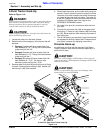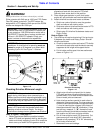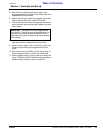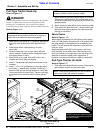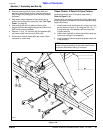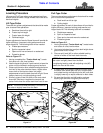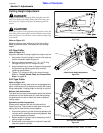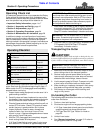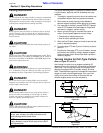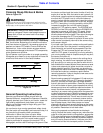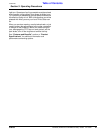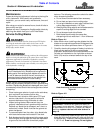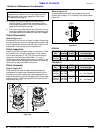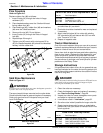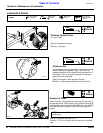
25
Section 3: Operating Procedures
5/09/08
RCR2596, RCR2510 and RCRM2510 Rotary Cutters 312-753M
Land Pride
Table of Contents
Cutting Instructions
!
DANGER!
The use of front & rear safety shields is strongly recommended
to prevent injury or death caused by thrown objects! Gearbox
shields must be secured in place when operating to avoid injury
or death from entanglement in rotating drivelines.
!
DANGER!
Rotary Cutters have the ability to discharge objects at high
speeds. Therefore, the use of front & rear safety guards is
strongly recommended to prevent injury or death caused by
thrown objects!
!
CAUTION!
Damage may occur if exceeding the rated cutting capacity of
the cutter!
!
CAUTION!
Do not over speed PTO or machine damage may result. The 8’
model in this series is available in 540 RPM. The 10’ model in
this series is available in 540 RPM or 1000 RPM. Know what
your tractor requirements are.
!
WARNING!
The RCR25 series cutter is designed to cut grass and brush up
to 1” in diameter. Using his cutter for any other type of work
can damage the drive components, deck and support frame.
!
DANGER!
Do not use deck as a fan. Cutting blades are not properly
designed or guarded for this use. Using the deck as a fan can
result in injury and/or death.
!
DANGER!
Do not operate and/or travel across steep inclines where a
tractor can roll-over resulting in serious injury or death.
Consult your tractor’s manual for acceptable inclines the
tractor is capable of traveling across.
!
CAUTION!
Tractor PTO shield and all Rotary Cutter guards must be in
place at all times during operation!
IMPORTANT: Avoidcatching the hydraulic hoses on
brush, post, stumps, and other protrusions that
could damage and/or break them.
NOTE: Your cutter is equipped with free swinging
cutting blades to reduce shock loads to the cutter if
striking obstacles.
This cutter was designed to cut grass and medium brush
in right-of-ways, pastures and for shredding row crop
residues.
1. Thoroughly Inspect the area to be cut for debris and
unforeseen objects. Mark any potential hazards.
2. Start machine slowly allowing cutter blades to
become aligned properly before going to full power.
3. It is important to maintain correct RPM PTO speed.
Loss of PTO speed will allow blades to hinge back
and result in ragged, uneven cutting.
4. Never run fast enough to overload the tractor or
cutter. Ground speed depends on two things:
• The density of material being cut.
• Size of tractor operating the cutter.
5. After the first 50 feet, stop and check to see that the
cutter is adjusted properly.
6. Do not engage PTO with 3-point in the fully raised or
position.
7. Periodically disengage PTO, turn off tractor, remove
ignition key and check for foreign objects wrapped
around the rotor shaft. Block cutter deck up before
removing objects.
Turning Angles for Pull-Type Cutters
Refer to Figure 3-1 and 2-3:
Avoid tractor-to-cutter turning angles exceeding 35
degrees if the main driveline is a standard conventional
drive shaft. The turning angle may be increased to 80
degrees if equipped with a constant velocity driveline
shaft. These extreme angles are intended for intermittent
usage only and not prolonged usage. Plan your field
cutting to minimize the number of turns as well as
extreme angles where turns are necessary.
Conventional U-Joint Driveline
Figure 3-1
CV Driveline
Figure 3-2
11934
20795



